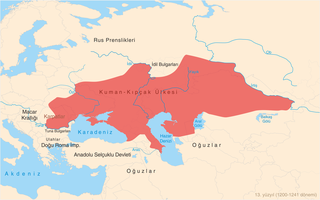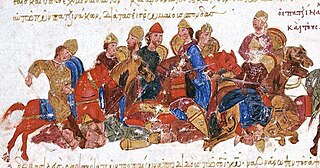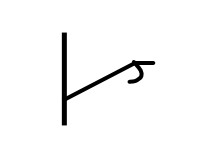Related Research Articles

The Oghuz Turks were a western Turkic people who spoke the Oghuz branch of the Turkic language family. In the 8th century, they formed a tribal confederation conventionally named the Oghuz Yabgu State in Central Asia. Today, much of the populations of Turkey, Azerbaijan and Turkmenistan are descendants of Oghuz Turks. Byzantine sources call them Uzes. The term Oghuz was gradually supplanted by the terms Turkmen and Turcoman by 13th century.
Seljuk, variously romanized, was an Oghuz Turkic warlord. He was the eponymous founder of the Seljuk dynasty and the namesake of Selçuk, the modern town near the ruins of ancient Ephesus in Turkey.

The Kipchaks or Qipchaks, also known as Kipchak Turks or Polovtsians, were Turkic nomads and then a confederation that existed in the Middle Ages inhabiting parts of the Eurasian Steppe.

Akçakoca is a town in Düzce Province, in the West Black Sea Region of Turkey, located about 200 km east of Istanbul. It is the seat of Akçakoca District. Its population is 27,878 (2022). The town was named after a Turkish chieftain of the 14th century CE who captured the area for the Ottoman Empire, and sports a statue in his honor. The town features a modern mosque of unusual design. Tourist attractions include beaches and a small ruined Genoese castle. It is the regional center of hazelnut cultivation.

The Pechenegs or Patzinaks were a semi-nomadic Turkic people from Central Asia who spoke the Pecheneg language. In the 9th and 10th centuries, the Pechenegs controlled much of the steppes of southeast Europe and the Crimean Peninsula. In the 9th century the Pechenegs began a period of wars against Kievan Rus', and for more than two centuries launched raids into the lands of Rus', which sometimes escalated into full-scale wars.

Anatolian beyliks were small principalities in Anatolia governed by beys, the first of which were founded at the end of the 11th century. A second and more extensive period of establishment took place as a result of the decline of the Seljuq Sultanate of Rûm in the latter half of the 13th century.

The Cumans or Kumans were a Turkic nomadic people from Central Asia comprising the western branch of the Cuman–Kipchak confederation who spoke the Cuman language. They are referred to as Polovtsy in Rus', Cumans in Western and Kipchaks in Eastern sources.
Cuman or Kuman was a West Kipchak Turkic language spoken by the Cumans and Kipchaks; the language was similar to today's various languages of the West Kipchak branch. Cuman is documented in medieval works, including the Codex Cumanicus, and in early modern manuscripts, like the notebook of Benedictine monk Johannes ex Grafing. It was a literary language in Central and Eastern Europe that left a rich literary inheritance. The language became the main language of the Golden Horde.

The Karamanlides, also known as Karamanli Greeks or simply Karamanlis, are a traditionally Turkish-speaking Greek Orthodox people native to the region of Karaman in Anatolia.

The Seljuk dynasty, or Seljukids, Seljuqs, also known as Seljuk Turks, Seljuk Turkomans or the Saljuqids, was an Oghuz Turkic, Sunni Muslim dynasty that gradually became Persianate and contributed to Turco-Persian culture in West Asia and Central Asia. The Seljuks established the Seljuk Empire (1037–1194), the Sultanate of Kermân (1041–1186) and the Sultanate of Rum (1074–1308), which stretched from Iran to Anatolia and were the prime targets of the First Crusade.
The Turkic migrations were the spread of Turkic tribes and Turkic languages across Eurasia between the 6th and 11th centuries. In the 6th century, the Göktürks overthrew the Rouran Khaganate in what is now Mongolia and expanded in all directions, spreading Turkic culture throughout the Eurasian steppes. Although Göktürk empires came to an end in the 8th century, they were succeeded by numerous Turkic empires such as the Uyghur Khaganate, Kara-Khanid Khanate, Khazars, and the Cumans. Some Turks eventually settled down into sedentary societies such as the Qocho and Ganzhou Uyghurs. The Seljuq dynasty settled in Anatolia starting in the 11th century, resulting in permanent Turkic settlement and presence there. Modern nations with large Turkic populations include Kyrgyzstan, Turkmenistan, Turkey, Azerbaijan, Uzbekistan and Kazakhstan, and Turkic populations also exist within other nations, such as Chuvashia, Bashkortostan, Tatarstan and the Sakha Republic of Siberia in Russia, Northern Cyprus, the Crimean Tatars, the Kazakhs in Mongolia, the Uyghurs in China, and the Azeris in Iran.
The name for the country Turkey is derived from the Medieval Latin Turchia, Turquia. It is first recorded in Middle English, attested in Chaucer, c. 1369. The Ottoman Empire was commonly referred to as Turkey or the Turkish Empire among its contemporaries. The word ultimately originates from the autonym Türk, first recorded in the Bugut inscription and the Hüis Tolgoi Inscription of the 6th century, and later, in the Orkhon inscriptions and the Tariat inscriptions (𐱅𐰇𐰼𐰜) of the 8th century.
The Seljuk Empire, or the GreatSeljuk Empire, was a high medieval, culturally Turco-Persian, Sunni Muslim empire, established and ruled by the Qïnïq branch of Oghuz Turks. The empire spanned a total area of 3.9 million square kilometres from Anatolia and the Levant in the west to the Hindu Kush in the east, and from Central Asia in the north to the Persian Gulf in the south, and it spanned the time period 1037 - 1308, though Seljuk rule beyond the Anatolian peninsula ended in 1194.

The Oghuz Yabgu State or Oghuz ili was a Turkic state, founded by Oghuz Turks in 766, located geographically in an area between the coasts of the Caspian and Aral Seas. Oghuz tribes occupied a vast territory in Kazakhstan along the Irgiz, Yaik, Emba, and Uil rivers, the Aral Sea area, the Syr Darya valley, the foothills of the Karatau Mountains in Tien-Shan, and the Chui River valley. The Oghuz political association developed in the 9th and 10th centuries in the basin of the middle and lower course of the Syr Darya and adjoining the modern western Kazakhstan steppes.

Abu Suleiman Dawud Chaghri Beg ibn Mikail, widely known simply as Chaghri Beg (989–1060), Da'ud b. Mika'il b. Saljuq, also spelled Chaghri, was the co-ruler of the early Seljuk Empire. The name Chaghri is Turkic and literally means "small falcon", "merlin".

Qiniq also spelled Qïnïq, Qynyk or Qynyq, was an Oghuz Turkic tribe.

This article summarizes the History of the western steppe, which is the western third of the Eurasian steppe, that is, the grasslands of Ukraine and southern Russia. It is intended as a summary and an index to the more-detailed linked articles. It is a companion to History of the central steppe and History of the eastern steppe. All dates are approximate since there are few exact starting and ending dates. This summary article does not list the uncertainties, which are many. For these, see the linked articles.

Turkoman, also known as Turcoman, was a term for the people of Oghuz Turkic origin, widely used during the Middle Ages. Oghuz Turks were a western Turkic people that, in the 8th century A.D, formed a tribal confederation in an area between the Aral and Caspian seas in Central Asia, and spoke the Oghuz branch of the Turkic language family.

Turkic history is the systematic documentation and study of events involving the Turkic peoples.

Manavs or Manav Turks are a Turkic people living in northwest Anatolia, especially in Sakarya, Bilecik, Balıkesir, Bursa, Çanakkale, Kocaeli, Eskişehir, Bolu and Düzce provinces. It is proposed that Manavs descend from Cumans and Kipchaks who settled in the Byzantine Empire.
References
- 1 2 3 Sümer, Faruk (2007). "Oğuzlar". TDV Encyclopedia of Islam, Vol. 33 (Nesi̇h – Osmanlilar) (in Turkish). Istanbul: Turkiye Diyanet Foundation, Centre for Islamic Studies. pp. 325–330. ISBN 978-975-389-455-5.
- ↑ "Selçuk Bey ve Hazarlar: Kim Kime Ne Yaptı?" (in Turkish). 2014-02-22. Retrieved 2024-05-20.
- ↑ "Uzlar (Oğuzlar)". Türk Tarihi (in Turkish). 17 June 2013. Retrieved 2024-05-20.
- ↑ "Paid Turkic Soldiers in the Byzantine Army (XI.-XII. Centuries)", Selçuk University Journal of Turkic Studies, P. 25, 2009, p. 53-69.
- ↑ "The Byzantine Empire's Transfer of Cuman-Area Communities from the Balkans to Anatolia Against the Turkish Expansion in Western Anatolia"
- ↑ "IV. Two Rivals Struggling in Western Anatolia After the Crusade: The Latin Kingdom of Istanbul and the Empire of Nicaea", Cihannüma Journal of History and Geography Studies, p.1, July, 2015, p. 9-25.
- ↑ The Late Byzantine Army Arms and Society 1204-1453, University of Pennsylvania Press, Philadelphia, 1992
- ↑ BASKICI, M. Murat, Anatolian Economic and Social Structure in the Byzantine Era (900-1261), 2nd Edition, Phoenix Publishing House, Ankara, 2009.
- ↑ BELDICEANU-STEINHERR, Irene, "Non-Muslim Population in Bithynia (second half of 14th century - first half of 15th century)" , Ottoman Principality 1300-1389, ed. Elizabeth A. Zacharadou, trans. Gul Cagali Guven, Ismail Yergun, Tülin Altinova, 2nd Edition, History Foundation Yurt Publishing, Istanbul, 1997, p. 8-22.
- ↑ GOLUBOVSKİY, P.V., Peçenegi, Torki i Polovtsı Rus i Step Do Nashestviya Tatar, Veche, Moskva, 2011.
- ↑ The Last Centuries of Byzantium 1261-1453, trans. . Bilge Umar, Türkiye İş Bankası Kültür Yayınları, İstanbul, 2016.
- ↑ ÖZTÜRK, Meriç T., The Provincial Aristocracy In Byzantine Asia Minor (1081-1261), Boğaziçi University, Unpublished Master Thesis, İstanbul, 2013 .
- ↑ VASARY, Istvan, Cumans and Tatars Eastern Soldiers in the Pre-Ottoman Balkans (1185-1365), 2nd Edition, trans. Ali Cevat Akkoyunlu, Yapı Kredi Publications, Istanbul, 2015
- ↑ WOLF, Robert Lee, "The Latin Empire Of Constantinople 1204-1261", A History Of The Crusaders, Volume II Later Crusades (1189-1311), General ed. Kenneth M. Setton, ed. by. Robert Lee Wolf and Harry W. Hazard, The University of Wisconsin Press, Madison, Milwaukee and London, 1969, p. 187-233.
- ↑ "A Broken Mirror: The Kipchak World In The Thirteenth Century", The Other Europe in the Middle Ages, Avars, Bulgars, Khazars and Cumans, ed. by. Florin Curta, Roman Kovalev, Brill, Leiden-Boston, 2008, p. 379-412.
- ↑ KEÇİŞ, Murat, "XIII.-XIV. Northwest Anatolian Road Networks According to Century Byzantine and Islamic Sources", Belleten, C. LXXVII, P. 280, 2013, Ankara, p. 849-874.
- ↑ Özdemİr, Mustafa (2017). "14-17. Yüzyillar Arasinda Anadolu'ya Gelen Türk Göçlerİ Ve Anadolu'nun Doğusunda Meydana Gelen Demografİk Değİşmeler" [Between The 14th And 18th Centuries, Turkish Migration In Anatolia And Changes In The Demographic Structure Of The Eastern Anatolia]. Akra International Journal of Culture Art Literature and Educational Sciences (in Turkish). 5 (12): 51–76.
- ↑ Yalvar, C. (2021). "ANADOLU'DA SON TÜRK İSKÂNI: İZNİK İMPARATORLUĞU'NDA KUMAN-KIPÇAKLAR VE YALOVA KAZIMİYE (YORTAN) İLE ELMALIK (SARUHANLI) KÖYLERİNDEKİ VARLIKLARI" [LAST TURKISH SETTLEMENT IN ANATOLIA: KUMAN-KIPÇAKS IN THE İZNİK EMPIRE AND ITS ASSETS IN THE VILLAGES OF YALOVA KAZIMİYE (YORTAN) AND ELMALIK (SARUHANLI) VILLAGES]. Turkish World Studies (in Turkish). 127: 11–36. Archived from the original on 19 April 2021. Retrieved 9 July 2022.
- ↑ "Anadolu'ya yerleştirilen Kumanlar (Manavlar)".
- ↑ Yilmaz, Adil (2018). "Bızans'in Anadolu'ya Yerleştırdığı Son Türkler" [The Last Turks Settled in Anatolia by Byzantium]. Eski̇çağ Araştirmalari Dergi̇si̇[Journal of Ancient Researches] (in Turkish) (3): 29–32.
- ↑ "Acar, Kenan (2010). Kuzeybatı Anadolu Manav Türkmen Ağızları Üzerine Birkaç Not" (PDF).
- ↑ "Muharrem ÖÇALAN SAKARYA- İZMİT YÖRESİ YERLEŞİK TÜRKMENLERİ MANAV AĞIZLARINDA ÖTÜMSÜZ PATLAYICI ÜNSÜZ DEĞİŞMELERİ" (PDF).
- ↑ Acar, Kenan (January 2022). "GAGAVUZ TÜRKÇESİ İLE KOCAELİ YERLİ (MANAV) AĞIZLARI ARASINDAKİ PARALELLİKLER, 2022, VI. Uluslararası Türklerin Dünyası Sosyal Bilimler Sempozyumu, PARALLELS BETWEEN GAGAVUZ TURKISH AND KOCAELİ NATİVE TURK (MANAV) DİALECTS, Kenan Acar, 2022, VI. International Turkish World Social Sciences Symposium". Vi. Uluslararası Türklerin Dünyası Sosyal Bilimler Sempozyumu.